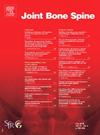Transcutaneous neurostimulation parameters for neuropathic radicular pain: Results from a two period crossover randomized trial
IF 3.8
3区 医学
Q1 RHEUMATOLOGY
引用次数: 0
Abstract
Objectives
Transcutaneous neurostimulation (TENS) is commonly used in the treatment of chronic radicular pain, but without any consensus on the type of current to be delivered. The aim of this study was to compare the conventional high-frequency, low-intensity current called c-TENS with a mixed current called m-TENS, combining c-TENS with a low-frequency, high-intensity current.
Methods
This was a single-blind, two-period crossover randomized trial. Included patients had chronic (≥ 3 months), neuropathic (dn4 ≥ 4) radicular pain of at least moderate intensity (Visual Analogic Scale [VAS] ≥ 40 mm [0–100 mm]). Patients were randomized to receive either c-TENS or m-TENS first, then the other, and both during one month. The primary outcome was the level of radicular pain, measured by VAS at the end of each of the two period.
Results
Seventy-four patients were included (mean age: 51.9 ± 13.5 years, female proportion: 65.6%). The mean duration of radicular pain was 45.2 ± 51 months and the mean radicular intensity was 67 ± 12.5/100 mm. After one month of treatment, VAS decreased to 53.9 ± 20.1 mm under c-TENS and to 53.9 ± 21.3 under m-TENS (NS). Thirteen patients (20.3%) had a VAS < 40/100 with either c-TENS or m-TENS (NS). Tolerance was the same for the two modes. Twenty-nine patients (46%) designated c-TENS as the most effective mode, and 34 patients (54%) designated m-TENS.
Conclusion
This study shows no difference in terms of efficacy or tolerance between c-TENS and m-TENS. There is no justification for preferring one of these two modes over the other for the treatment of chronic neuropathic radicular pain.
治疗神经根性疼痛的经皮神经刺激参数:两期交叉随机试验的结果。
目的:经皮神经刺激(TENS)是治疗慢性根性疼痛的常用方法,但对于电流的类型尚未达成共识。本研究旨在比较传统的高频低强度电流(c-TENS)和混合电流(m-TENS)(c-TENS 与低频高强度电流相结合):这是一项单盲、两阶段交叉随机试验。纳入的患者均为慢性(≥3 个月)、神经性(dn4≥4)根性疼痛,疼痛强度至少为中等(视觉模拟量表(VAS)≥40 毫米(0-100 毫米))。患者被随机分配到先接受 c-TENS 或 m-TENS,然后接受另一种治疗,或在一个月内同时接受两种治疗。主要结果是两个疗程结束时的根性疼痛程度,以 VAS 进行测量:共纳入 74 名患者(平均年龄:51.9 ± 13.5 岁,女性比例:65.6%)。根性疼痛的平均持续时间为 45.2 ± 51 个月,平均根性疼痛强度为 67 ± 12.5/100毫米。治疗一个月后,c-TENS 下的 VAS 降为 53.9 ± 20.1 mm,m-TENS 下的 VAS 降为 53.9 ± 21.3(NS)。13名患者(20.3%)在接受 c-TENS 或 m-TENS 治疗后,其 VAS < 40/100(无)。两种模式的耐受性相同。29 名患者(46%)认为 c-TENS 是最有效的模式,34 名患者(54%)认为 m-TENS 是最有效的模式:这项研究表明,c-TENS 和 m-TENS 在疗效和耐受性方面没有差异。结论:这项研究表明,在治疗慢性神经根性疼痛方面,c-TENS 和 m-TENS 在疗效和耐受性方面均无差异。
本文章由计算机程序翻译,如有差异,请以英文原文为准。
求助全文
约1分钟内获得全文
求助全文
来源期刊

Joint Bone Spine
医学-风湿病学
CiteScore
4.50
自引率
11.90%
发文量
184
审稿时长
25 days
期刊介绍:
Bimonthly e-only international journal, Joint Bone Spine publishes in English original research articles and all the latest advances that deal with disorders affecting the joints, bones, and spine and, more generally, the entire field of rheumatology.
All submitted manuscripts to the journal are subjected to rigorous peer review by international experts: under no circumstances does the journal guarantee publication before the editorial board makes its final decision. (Surgical techniques and work focusing specifically on orthopedic surgery are not within the scope of the journal.)Joint Bone Spine is indexed in the main international databases and is accessible worldwide through the ScienceDirect and ClinicalKey platforms.
 求助内容:
求助内容: 应助结果提醒方式:
应助结果提醒方式:


